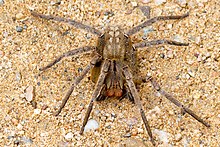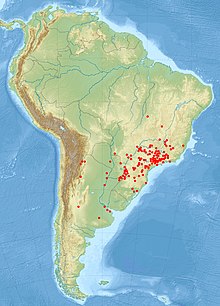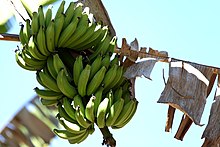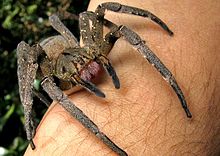Brazilian wandering spider
| Brazilian wandering spider | ||||||||||||
|---|---|---|---|---|---|---|---|---|---|---|---|---|

Brazilian wandering spider ( Phoneutria nigriventer ), female |
||||||||||||
| Systematics | ||||||||||||
|
||||||||||||
| Scientific name | ||||||||||||
| Phoneutria nigriventer | ||||||||||||
| ( Keyserling , 1891) |
The Brazilian wandering spider ( Phoneutria nigriventer ), sometimes also called the Brazilian comb spider , is a spider from the family of comb spiders (Ctenidae). The species, which is mainly found in the south-east of Brazil and in places in the north of Argentina , is one of the world's largest representatives of the real spiders and, like others of the genus Phoneutria, is well known because of the danger it poses; their bite can be fatal even for a healthy adult, especially since the possibility of bite accidents is increased by the high level of aggressiveness and the high probability of meeting due to the frequent occurrence of the spider in urban regions. However, the threat to humans posed by the Brazilian wandering spider is far less than is often assumed. It also contains the neurotoxin (nerve poison) Phα1β contained in the spider's poison , which could possibly be of medicinal use as an analgesic .
The Brazilian wandering spider, together with other spiders in the family, is simply referred to as the wandering spider or, like other representatives of the genus Phoneutria, as the banana spider . However, this name is also used for individual species of the genus Cupiennius within the family of fishing spiders (Trechaleidae). The reason for this is that in the past individuals of both genera were unknowingly exported in banana trees to other continents of the world. Especially with the partially very similar representatives of the genus Cupiennius , confusion with those of the genus Phoneutria including the Brazilian wandering spider can occur, which can have devastating consequences due to the danger posed by the species of the genus Phoneutria including the Brazilian wandering spider . The spiders of the genus Cupiennius, on the other hand, are much more harmless to humans than those of the genus Phoneutria .
The English and in this language ambiguous trivial names Brazilian Wandering Spider and Banana spider have the same meaning as the German names “Brasilianische Wanderspinne” and “Bananenspinne”. Here, too, the name Banana spider mitutner is used for individual species of the genus Cupiennius and, in English, also for the more harmless warm-house giant crab spider ( Heteropoda venatoria ) from the giant crab spider family (Sparassidae), which, however, does not optically match the species of the two previous genera resembles. Like these and various species of the genus Phoneutria and Cupiennius , the Brazilian wandering spider is occasionally kept as a pet in the field of terrariums .
features
The body structure of the Brazilian wandering spider corresponds to that of other species of the genus Phoneutria , which means that it is also a large and robustly built comb spider and, like other species of the family, reminiscent of wolf spiders (Lycosidae).
The species reaches a body length of 30 to 50 millimeters, while the leg span can amount to 180 millimeters. When measuring the leg span, the body of the spider in between must also be taken into account. A single leg of the spider reaches a length of mostly 60 millimeters.
The body length makes the Brazilian wandering spider , together with similarly sized species of the genus, one of the world's largest species within the suborder real spiders . The leg span is only exceeded within this subordination by some species of the genus Ancylometes, which also belongs to the comb spiders, and some giant crab spiders (Sparassidae).
The entire body of the Brazilian wandering spider is dorsally light brown to brown to gray in color and also covered with short brown to gray hair.
Prosoma

Viewed from above, the carapace (back shield of the prosoma or front body) takes on an oval shape. On the anterior (previous) side, it appears rounded and trimmed on the back. In general, the carapace is longer than it is wide. The widest section is between the coxae (hip joints) of the second and third pair of legs. In the coxae of the first pair of legs, the carapace is narrowed. The side edges of the carapace are each marked with a black line. The fovea ( apodem ) is longitudinally shaped. It is colored black and has several black diverging radial stripes.
The eyeball appears swollen and protruding. The eyes are arranged in two rows one above the other. Both rows of eyes each have four eyes and are bent back. The four central eyes are square to one another and the side eyes are arranged in pairs further back one above the other. In contrast to the other circular eyes, the upper side eyes are oval in shape and smaller. The lower median eyes are a little further apart than half of their diameter. The distance between the upper side and middle eyes corresponds to the diameter of the upper middle eyes. The lower and upper side eyes are each as far apart as it corresponds to the radius of the lower central eyes. The distance between the lower and the upper middle eyes is slightly smaller than the diameter of the lower middle eyes themselves and that of the lower middle eyes and the lower side eyes corresponds to the diameter of the upper middle eyes.
The height of the clypeus (section between the front pair of eyes and the edge of the carapace) also corresponds to the diameter of the lower median eyes. The actually dark brown colored chelicerae (jaw claws) are particularly noticeable because of the red colored setae (hair). This coloring serves as a signal color. The chelicerae also have three promarginal (inside front) and five retromarginal (inside back) teeth. The length of the maxilla (parts of the mouth) is twice the length of the labium (lip). They are shaped slightly converging and trimmed on the distal side (edge side). Laterally the maxillae show a serrula (row of teeth) and anterior and median further scopulae. The labium is slightly shorter than it is wide. It has a used apex and is also movably connected to the sternum (breast shield of the prosoma ). The sternum itself is delimited by sinuous edges, while it is also trimmed anteriorly and tapering towards the rear.
extremities

The first pair of legs of the Brazilian wandering spider is the longest. This is followed by the fourth and then the second. The third pair of legs is the shortest. The tibiae (Greaves) and the Metatarsen (heel members of the tarsi or foot members) also have a Annsammlung of aufeinnanderdolgenden and mostly in pairs applied spines. The number of spines and their arrangement of the leg segments varies within the four pairs of legs. The tibiae of the first pair of legs each have four pairs of spines on the ventral side, and the metatarsi at the same position three. The situation is similar with the arrangement of the spines of the second pair of legs, but here the tibiae each have a spine on the prolateral side. On the other hand, the tibia of the third pair of spines have only three pairs of spines, but there are two separate spines on the pro- and retrolateral side. The spines of the metatarsi of the third pair of legs largely correspond to that of the tibia, but there is another pair of spines adjacent to the individual spines on the pro- and retrolateral side. The arrangement of the spines of the fourth pair of legs is completely the same as that of the previous one.
The trochanters (thigh rings) are notched. Noteworthy is the dense scopulae (thick leg hairs ), which are located on the prolateral (laterally facing the body) side of the pedipalps (transformed extremities in the head area), the tibia and the tarsi. The tarsi each have two comb-shaped claws and claw tufts. In addition, two rows of Trichobothria ( whisker hairs) are formed dorsally on the meta- and tarsi . The bases of the Trichobothria in turn show several transversely applied ridges. The basic color of the legs, like the rest of the body, is also brown. For the purpose of threatening gestures, the Brazilian wandering spider, like some other species of the genus, also has visible black and yellow or white stripes on the underside of the two front pairs of legs.
Opisthosoma
The dorsally light to dark brown colored opisthosoma (abdomen) is characterized by two longitudinal lines made up of faint dots. At the rear edge of these lines, black dots are formed in some individuals. The underside is uniform and colored from orange to brown to black, depending on gender. This is also a warning color that is used in the threatening gesture .
Behind the book lungs (respiratory organs) are radial bands with white dots that separate at the spinnerets . As with all species of the genus Phoneutria, the spinnerets lack a cribellum (organ for producing fishing wool), which consequently makes the Brazilian wandering spider an ecribellate spider.
Sexual dimorphism
Like many spiders, the Brazilian wandering spider has a pronounced sexual dimorphism (difference between the two sexes), which, like the other representatives of the genus, is characterized by size - the male is also smaller than the female here. Furthermore, the ventral side of the opisthosoma in males is lighter in color and mostly appears in orange to brown hues, while this area is colored dark brown to black in males.
Genital morphological features
The bulbi (male sexual organs) of the Brazilian wandering spider are partly elliptical and the emboli (import organs of the bulbi) are straight and narrow. The emboli have a narrow base and, on the prolateral (frontal forward) side, also have a slightly raised marginal keel.
The flat epigyne (female sexual organ) of the species has cylindrical lateral margins. The side field of the epigyne near the copulation opening is not grooved in the Brazilian wandering spider, unlike in the other representatives of the genus, and the sides of the apophysis ( chitinized process) have no sulci (furrows).
toxicology
With the help of toxicology (poison theory), the components of the poison of the Brazilian wandering spider could be analyzed in parts. This contains some enzymes , among other neurotoxic acting peptides and proteins, the ion channels and receptors of the neuromuscular system as may affect invertebrate both vertebrates. The poison secretion probably contains up to 150 compounds, 54 of which have been documented so far. Further, cysteine-containing species-specific toxins, called "PnTxs" ( P honeutria n igriventer t o x in s ) contained. Several high molecular weight proteins are suspected, only a few of which have been described so far. These properties make the poison much more effective than the poisons of other dangerous spiders such as the Sydney funnel- web spider ( Atrax robustus ) or the southern black widow ( Latrodectus mactans ). Furthermore, the comparatively large Brazilian wandering spider can administer injections in eight times the amount of the much smaller real widows ( Latrodectus ).
Similar species
The Brazilian wandering spider resembles not only the wolf spiders but also representatives of other spider families within the superfamily of the Lycosoidea .
Similarities to other species in the genus Phoneutria
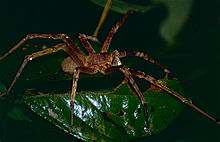
The species of the genus Phoneutria, including the Brazilian wandering spider, all look very similar, which is why confusion is possible here too. This also applies to the colors of the different species. The dorsally applied brown basic coloration is present in all representatives of the genus Phoneutria and the Brazilian wandering spider also shares the possession of red-appearing chelicerae with the large banana spider ( P. boliviensis ), Phoneutria fera and Phoneutria keyserlingi . Within the genus itself, the Brazilian wandering spider looks most similar to the species Phoneutria eickstedtae , Phoneutria keyserlingi and Phoneutria pertyi . The female of the Brazilian wandering spider differs from these in particular in that it has a significantly darker color on the ventral area of the opisthosoma.
The most reliable method of differentiating the four aforementioned species is to distinguish between the genital morphological features of these. The bulbi of the male of the Brazilian wandering spider differ from those of the males of Phoneutria keyserlingi and Phoneutria pertyi by the straight embolus with the weakly pronounced and prolateral keel. In Phoneutria eickstedtae , the base of the emboli is much wider. In Phoneutria keyserlingi, the epigyne is raised differently than in the Brazilian wandering spider and the side field of the epigyne near the copulation opening is also grooved in the other species. From the epigyne of the females of the other two species, that of the female of the Brazilian wandering spider differs in the flat center and the absence of the basal sulci in the lateral apophysis of the epigyne. In Phoneutria eickstedtae and Phoneutria pertyi , the middle field of the epigyne is convex and the lateral apophysis has sulci.
Similarities with species of the genus Ctenus and other comb spiders

The representatives of the genus Phoneutria, including the Brazilian wandering spiders, can be confused with the species of the genus Ctenus, which also belongs to the family of comb spiders, and others of the family. However, the species of the genus Ctenus are significantly smaller and can sometimes be distinguished from the Phoneutria species by the position of the eyes . In the genus Ctenus, the outer eyes are not on a common elevation and are further apart.
Another definite distinguishing feature of the genus Phoneutria and the great wandering spider , which can be used as a safe contrast to the genus Ctenus and other comb spiders, is the presence of the dense scopulae on the pedipalps, a property that all other comb spiders lack.
Similarities with species of the genus Cupiennius
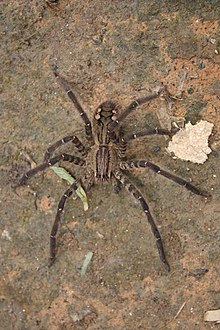
The Brazilian wandering spider, like other species of the genus Phoneutria, is occasionally confused with those of the genus Cupiennius from the family of fishing spiders (Trechaleidae), which are much more harmless to humans . Confusion can also arise because species of both genera are occasionally also exported to other continents on fruit bushes of the dessert banana ( Musa × paradisiaca ) (see section “ Imports through banana fruits ”).
The Brazilian wandering spider, however, like other species of the genus, has a much less contrasting basic color and also red chelicerae (jaw claws), a property that almost all species of the genus Cupiennius lack. In addition, the Brazilian wandering spider surpasses all species of the genus Cupiennius in terms of body size .
Occurrence
According to its trivial name, the Brazilian wandering spider is preferred in Brazil , where it is found in the states of Minas Gerais , Goiás , Mato Grosso do Sul , Espírito Santo , Rio de Janeiro , São Paulo , Paraná , Santa Catarina and Rio Grande do Sul . The species also inhabits the Mata Atlântica and the wooded areas of the Cerrados within Brazil. To the south the distribution area extends to Paraquay and the north of Argentina . In Uruguay , the Brazilian wandering spider was also introduced through banana exports.
In particular, evidence from Uruguay's capital, Montevideo, and Argentina 's capital, Buenos Aires , presumably goes back to abducted and naturalized animals that came to these cities via banana exports. Due to ambiguities in the synonymy and name use (see section Systematics), older information on the location can sometimes be related to other species.
Habitats

Like the other species of the genus Phoneutria , the Brazilian wandering spider prefers rainforests , where it usually hangs on trees.
Together with Phoneutria keyserlingi , the Brazilian wandering spider is the only species of the genus that shows a high degree of adaptability to human settlements and thus a certain synanthropy (preference for human habitats), which means that both species can occur in smaller towns as well as in more urban regions. Equally both Phoneutria keyserlingi and the Brazilian wandering spider common in buildings.
Import through banana fruits
The term "banana spider" used for the same reason for other species of the genus and some of the genus Cupiennius from the family of fishing spiders (Trechaleidae) is due to the fact that specimens of the Brazilian wandering spider are occasionally imported into other continents through the import of perennials the dessert banana ( Musa × paradisiaca ) comes. This can be justified by the fact that the perennials transported as such offer the spiders hiding places and these are gladly accepted as such by the species, which live mostly hidden during the day, where they can then be overlooked. However, the probability of specimens of the Brazilian wandering spider on banana fruits for sale in Europe is very low, as only 0.8% of the banana fruits sold there come from Brazil.
Found reports in the German-speaking area
A supposed banana spider turned out to be harmless in a fruit hall in Hamm, North Rhine-Westphalia, at the beginning of May 2019.
On the night of May 2nd to 3rd, 2019, a spider was discovered in the hall of a fruit wholesaler in the Graz-Umgebung district , which, according to an employee's description, was identified as a banana spider. Since it was not found despite packing a box, a larger shipment from Colombia was refrigerated and blocked.
In July 2020, a Brazilian wandering spider was discovered in a fruit crate in a supermarket in Blankenburg (Harz) . After the market was evacuated by the police and fire brigade, the spider was killed.
Threat and protection
There is no information about possible threats to the population of the Brazilian wandering spider, as their populations are not assessed by the IUCN .
Way of life
Like all comb spiders (Ctenidae), the Brazilian wandering spider is predominantly nocturnal and often hides during the day under leaves, wood or in abandoned termite mounds . At night, however, the species becomes much more active and its activity radius can be up to 100 meters. The nomadic Brazilian wandering spider does not create nets to hide or catch prey.
Defense behavior
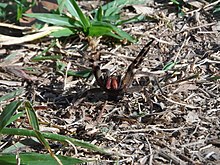
The Brazilian wandering spider, like the other species of the genus, behaves very aggressively in the event of disturbances and, when encountering possible predators (predators), first assumes a characteristic threatening position in which it straightens itself up as well as the first pair of legs and the pedipalps and shows the chelicerae. A bite can follow if the spider continues to be provoked. The extremely effective poison can also have life-threatening effects for humans (see section “ Toxicity ”).
Hunting behavior and catch of prey
The hunting behavior of the Brazilian wandering spider also corresponds to that of other comb spiders (Ctenidae) and it hunts accordingly as a stalker . During the hunt, the visual and vibration senses, which work with the help of the sensilla, are used. If the Brazilian wandering spider has located a prey, it sneaks up on it and snaps towards the prey as soon as it is within range, holds it with its legs and injects its venom. Larger prey animals are spun in. The prey spectrum of the Brazilian wandering spider includes other arthropods and small vertebrates such as smaller amphibians and reptiles , and occasionally smaller rodents .
Phenology and reproduction
Like many species living in tropical regions, the Brazilian wandering spider is active all year round. The mating season falls in April and May. If a sexually mature male has found a female, it begins with courtship behavior in which it first drums the pedipalps before slowing this process and then moving on to another movement in which the abdomen is raised and lowered. Then males and females slowly approach each other if the latter is willing to mate. The male mounts the female from above and then alternately introduces his bulbs into the female's epigyne . The male then leaves the female and cannibalism on the part of the female usually does not occur .
After about two weeks, the female builds her first egg cocoon, which can contain over 3000 eggs, and guards it until the young spiders hatch. The hatched young animals are also guarded for some time before they become independent and leave the nest. A fertilized female can produce up to four cocoons. The young spiders need three years to reach adulthood, during which they moult several times. The number of moults depends on the temperature and the food available. In the first year the young spiders molt five to ten times, in the following three to seven times. The number of molts in the third year is only two or three. Sexual maturity is associated with the last moult.
The entire lifespan of the Brazilian wandering spider can be up to six years.
Systematics
The scientific species name nigriventer comes from the Latin language and means "black ventral width", which comes from the dark underside of the Brazilian wandering spider.
The species was first described as Ctenus nigriventer in 1891 by Eugen von Keyserling , after a female collected by Hermann von Ihering in the Brazilian state of Rio Grande del Sul. In 1936 the Brazilian arachnologist Cândido Firmino de Mello-Leitão transferred the species as Phoneutria nigriventer to the genus Phoneutria described by Maximilian Perty in 1833 , in which it has remained ever since. The delimitation from the genus Ctenus had been viewed as doubtful from research to the revision by Mello-Leitão. However, it has been confirmed in recent research.
The delimitation and description of the species within the genus has been unclear and controversial until recently. Wolfgang Bücherl mistakenly considered Phoneutria nigriventer to be a synonym for Phoneutria fera . The species Phoneutria keyserlingi and Phoneutria pertyi , which are now again regarded as valid, were synonymous with Phoneutria nigriventer during a revision in 2001 , but this synonymy was revoked in 2007. The types are mainly differentiated according to genital characteristics (details in the shape of the female epigyne and the male embolus). In addition, one color feature is characteristic: in Phoneutria nigriventer , the opisthosoma on the ventral side is uniformly brown to black, in most related species it is lighter.
In the current version, the following names are regarded as synonyms of Phoneutria nigriventer : Ctenus rufichelis Mello-Leitão , 1917 (= Phoneutria rufichelis ), Ctenus paca Mello-Leitão , 1922 (= Phoneutria paca ), Ctenus luederwaldti Mello-Leitão , 1927 (= Phoneutria luederwaldti ).
Brazilian wandering spider and human
The Brazilian wandering spider , together with the species Phoneutria fera, is considered to be the most poisonous species of the genus and, together with it, the most poisonous spider of all. Their venom makes the species one of the few whose effects can have life-threatening consequences even for a healthy adult. Accordingly, the species is often feared. Occasionally, however, it is also kept as a pet (see section " Terraristics ").
danger
Due to their very aggressive nature and their mobility and toxicity, the Brazilian wandering spider poses a risk factor that should not be underestimated. However, this is not only due to the high level of aggressiveness and agility of the species, but also from the high probability of a meeting between humans and spiders, as, in contrast to the predominantly remote Phoneutria fera, they also like to stay in settlement areas. The spiders also look for the inside of human dwellings, where they can look for hiding places such as clothing or household utensils due to their way of life, which is hidden during the day, and where they can go unnoticed. A bite can occur when the objects are used or lifted and the spiders unexpectedly approach, which can cause them to defend themselves with one bite. Bites by males occur especially during the mating season, as they often end up in houses when looking for females.
However, the danger posed by the Brazilian wandering spider to humans is far less than is often feared. The widespread assumption that the species occasionally gets to Germany by means of banana transport is also incorrect in most cases. Likewise, deaths have fallen sharply, as an antidote now available prevents most deaths today. In the period between 1926 and 1996, 14 deaths have been documented that were attributed to the Brazilian wandering spider. Furthermore, of the countries within the distribution area of the species, only Brazil exports bananas to the European Union and only 0.8% of the bananas on German markets come from Brazil, which in any case reduces the likelihood of the often feared importation. In addition, the spiders found are mostly native spider species that got between the fruits during transport, or other spiders, such as other species of the genus Phoneutria or similar representatives of the comb spiders or the superfamily Lycosoidea, for example the great wandering spider ( Cupiennius salei ) (see section “ Importation through banana fruits ”). Incidents in Europe are correspondingly rare.
Bite accidents
The Brazilian wandering spider , like all species of the genus Phoneutria, has a very high level of aggressiveness or readiness to defend itself compared to many other spider species (see section " Defensive behavior "). Because of this, and because of the high probability that humans and spiders will come together, bite accidents of this type are not unlikely. A safety distance to the spider is therefore recommended.
A specimen of the species that feels threatened usually makes a threatening gesture typical of some spiders (see chapter "Defense behavior" and picture). However, there have also been reports of bites that occurred without warning from the spider. Due to its agility, the Brazilian wandering spider is also able to attack predators or supposed predators while jumping. Occasionally, the Brazilian wandering spider exerts so-called dry bites (bites in which the spider bites with the chelicerae, but does not administer poison), which then do not cause any complications with the exception of the pain from the bite itself and possible bacterial infections.
toxicity
The toxicity comprises the impact and the extent of various toxins, including the neurotoxic acting neurotoxin of the Brazilian wandering spider, which was investigated several times.
Toxic effect on humans
A bite from the Brazilian wandering spider can be associated with a variety of symptoms in humans. The first thing that occurs is great local pain at the bite site. Likewise, edema (swelling of body tissue), erythema (skin reddening), hyperhidrosis (excessive sweating), paresthesia (strong sensations in the supply areas of skin nerve) and muscular fasciculation (fine twitching of small muscle fiber bundle occur at the bite site). Tachycardia (racing heart), high blood pressure , priapism (painful erection), vomiting and sialorrhea (excessive salivation) can be signs of more acute physical damage (systemic effects) caused by the poison. Other severe symptoms that occur particularly in children are vomiting, priapism, diarrhea , bradycardia (decreased heartbeat), arterial hypotension (low blood pressure), cardiac arrhythmias , acute pulmonary edema and shock . If not treated, the poison of the Brazilian wandering spider can lead to death.
Toxic effects on animals
As a result of the research in the context of toxicology (poison science) of the poison of the Brazilian wandering spider, which was also carried out on experimental animals, results of the poisonous effects could also be recorded and documented.
In experiments in which mice were given injections of the venom of the species, one could u. A. Determine analgesic (pain-relieving) effects (also in the case of a morphine tolerance). These effects were caused by the neurotoxin (nerve poison) Phα1β . In adult rats and those at an age of eight weeks, perivascular edema (swelling of blood vessels), damage to the blood-brain barrier and convulsions were detected. In experiments with rabbits , cavernous bodies were formed , which were created by the polypeptides of the spider's venom.
Possible use of the poison
The analgesic effects that occur in mice after an injection of the poison of the Brazilian wandering spider with the neurotoxin Phα1β contained therein makes it possible to use this neurotoxin as a pain reliever . The peptide Tx2-6 that the bite priapism can cause (painful erections), possibly entails benefits as sexual enhancers .
Terrariums
Occasionally the Brazilian wandering spider is also kept as a pet in terrariums . For successful keeping, the tropical climate of its natural range should be simulated as well as possible. Hiding places must also be offered due to the spider's nocturnal and daytime hidden way of life. Before buying one or more specimens of the species, however, you should be aware of the danger it poses.
Individual evidence
- ↑ a b c d RS Vetter & S. Hillebrecht: Distinguishing Two Often-Misidentified Genera (Cupiennius, Phoneutria) (Araneae: Ctenidae) of Large Spiders Found in Central and South American Cargo Shipments , American Entomologist, Volume 54, Issue 2, 2008 , Pp. 88–93, accessed March 15, 2020.
- ↑ a b c d e f g h i j k l m Rosana Martins & Rogério Bertani (2007): The non-Amazonian species of the Brazilian wandering spiders of the genus Phoneutria Perty, 1833 (Araneae: Ctenidae), with the description of a new species , Zootaxa 1526, 2007, pp. 1–36, accessed August 30, 2020.
- ↑ a b c d e f g armed spiders - Entomology and Nematology Department at the University of Florida, accessed September 1, 2019
-
↑ a b Reference error: Invalid
<ref>tag; no text given for itemization with the name wandering-spiders . - ↑ a b c d e S. Borelli: Dermatological Noxa Catalog: Diseases of the skin and mucous membrane through contacts in work and the environment , Springer-Verlag, 2019, pp. 201–1542, 9783642703119.
-
↑ a b c d e f g h i j k l m Reference error: Invalid
<ref>tag; no text given for itemization with the name simó . - ↑ a b c d e MRV Diniz, ALB Paiva, C. Guerra-Duarte, MY Nishiyama, Jr., M, A. Mudadu, U. de Oliveira, MH Borges, JR Yates, I. de L. Junqueira-de- Azevedo: An overview of Phoneutria nigriventer spider venom using combined transcriptomic and proteomic approaches. In: PLOS ONE . Volume 13, number 8, 2018, p. E0200628, doi: 10.1371 / journal.pone.0200628 , PMID 30067761 , PMC 6070231 (free full text).
- ↑ Z. Maretić, D. Lebez: Araneism: With Special Reference to Europe , Araneism: With Special Reference to Europe, Volume 73, Edition 56021 of TT (United States. National Technical Information Service), Nolit Publishing House, 1979, pp. 86.
- ↑ Peters: Report on the achievements of the natural history of the arachnids during the years 1847 and 1848. University of Michigan (Ed.): Archives for natural history. Volume 15. Nicolai, 1849, p. 335.
- ↑ Lower Saxony portal: Banana spiders - and what's behind them , accessed on March 15, 2020.
- ↑ a b Natural History Museum Karlsruhe: Banana Spiders by Claudia Wesseloh, accessed on March 15, 2020
- ↑ North Rhine-Westphalia: Alleged banana spider turned out to be harmless kleinezeitung.at, May 3, 2019, accessed June 2, 2019.
- ↑ Alarm in camp: Dangerous spider crawled out of the banana box krone.at, May 3, 2019, accessed June 2, 2019.
- ↑ Poisonous spider in fruit box: Supermarket in Blankenburg evacuated. Mitteldeutscher Rundfunk , July 12, 2020, accessed on July 12, 2020 .
- ↑ a b Phoneutria nigriventer (Keyserling, 1891) from Global Biodiversity Information Facility , accessed on March 15, 2020
- ↑ a b c d e f g h i Phoneutria nigriventer (Keyserling, 1891) at Minax Tarantulas, accessed on May 8, 2019.
- ^ A b Phoneutria (Perty, 1833) at the University of Florida, Institute of Food and Agricultural Sciences, accessed May 8, 2019
- ↑ Phoneutria nigriventer (Keyserling, 1891) at Animal Corner, accessed May 8, 2019.
- ↑ Miguel Simó & Antonio D. Brescovit (2001): Revision and cladistic analysis of the Neotropical spider genus Phoneutria Perty, 1833 (Araneae, Ctenidae), with notes on related Cteninae. Bulletin of the British arachnological Society) 12 (2): 67-82.
- ↑ Phoneutria nigriventer (Keyserling, 1891) in the WSC World Spider Catalog , accessed March 15, 2020
- ↑ Focus: Bad thing , 2005
- ↑ Spiegel: British family finds deadly spider shopping for bananas , 2013
- ↑ Voice: Highly poisonous spider in a banana box , 2016
- ↑ Image: Briton finds deadliest spider in the world in bananas , 2018
- ↑ F. Rosa, G. Trevisan, F. Rigo, R. Tonello, EL de Andrade, MN Cordeiro, JB Calixto, MV Gomez, J. Ferreira: Phα1β, a peptide from the venom of the spider Phoneutria nigriventer shows antinociceptive effects after continuous infusion in a neuropathic pain model in rats. In: Anesthesia and analgesia. Volume 119, number 1, July 2014, pp. 196-202, doi: 10.1213 / ANE.0000000000000249 , PMID 24836473 .
- ^ Q. Ashton Acton, PhD: Arthropod Venoms - Advances in Research and Application: 2013 Edition: Scholarly Brief , ScholarlyEditions, 2013, p. 29, ISBN 978-1-4816-8532-0 .
- ^ University of Texas: Revista brasileira de genética, Volume 20, Issues 3-4 , Sociedade Brasileira de Genética, 1997, p. 767.
- ↑ CJ Castro-Junior, J. Milano, AH Souza, JF Silva, FK Rigo, G. Dalmolin, MN Cordeiro, M. Richardson, AG Barros, RS Gomez, MA Silva, C. Kushmerick, J Ferreira, MV Gomez: Phα1β Toxin prevents capsaicin-induced nociceptive behavior and mechanical hypersensitivity without acting on TRPV1 channels. In: Neuropharmacology. Volume 71, August 2013, pp. 237-246, doi: 10.1016 / j.neuropharm.2013.04.001 , PMID 23597507 .
- ↑ Wissenschaft.de: erection after a spider bite , accessed on March 5, 2020.
literature
- RS Vetter, S. Hillebrecht: Distinguishing Two Often-Misidentified Genera (Cupiennius, Phoneutria) (Araneae: Ctenidae) of Large Spiders Found in Central and South American Cargo Shipments . In: American Entomologist. Volume 54, Issue 2, 2008, pp. 88-93.
- S. Borelli: Dermatological Noxa Catalog: Diseases of the skin and mucous membranes through contacts in work and the environment. Springer-Verlag, 2019, ISBN 978-3-642-70311-9 .
- MRV Diniz, ALB Paiva, C. Guerra-Duarte, MY Nishiyama, Jr., M, A. Mudadu, U. de Oliveira, MH Borges, JR Yates, I. de L. Junqueira-de-Azevedo: An overview of Phoneutria nigriventer spider venom using combined transcriptomic and proteomic approaches. In: PLOS ONE . Volume 13, Number 8, 2018, p. E0200628, doi: 10.1371 / journal.pone.0200628 . PMID 30067761 , PMC 6070231 (free full text).
- F. Rosa, G. Trevisan, F. Rigo, R. Tonello, EL de Andrade, MN Cordeiro, JB Calixto, MV Gomez, J. Ferreira: Phα1β, a peptide from the venom of the spider Phoneutria nigriventer shows antinociceptive effects after continuous infusion in a neuropathic pain model in rats. In: Anesthesia and analgesia. Volume 119, number 1, July 2014, pp. 196-202, doi: 10.1213 / ANE.0000000000000249 . PMID 24836473 .
- Z. Maretić, D. Lebez: Araneism: With Special Reference to Europe. With Special Reference to Europe, Volume, Araneism 73, Issue 56021 of TT (United States. National Technical Information Service), Nolit Publishing House, 1979, p. 86.
- Q. Ashton Acton: Arthropod Venoms - Advances in Research and Application: 2013 Edition: Scholarly Brief. ScholarlyEditions, 2013, ISBN 978-1-4816-8532-0 , p. 29.
- University of Texas: Revista brasileira de genética, Volume 20, Issues 3-4. Sociedade Brasileira de Genética, 1997, p. 767.
- CJ Castro-Junior, J. Milano, AH Souza, JF Silva, FK Rigo, G. Dalmolin, MN Cordeiro, M. Richardson, AG Barros, RS Gomez, MA Silva, C. Kushmerick, J. Ferreira, MV Gomez: Phα1β Toxin prevents capsaicin-induced nociceptive behavior and mechanical hypersensitivity without acting on TRPV1 channels. In: Neuropharmacology. Volume 71, August 2013, pp. 237-246, doi: 10.1016 / j.neuropharm.2013.04.001 . PMID 23597507 .
Web links
- Phoneutria nigriventer in the World Spider Catalog
- Phoneutria nigriventer (Keyserling, 1891) at Global Biodiversity Information Facility
- Phoneutria nigriventer (Keyserling, 1891) at Minax Tarantulas
- Phoneutria nigriventer (Keyserling, 1891) at Animal Corner
- Phoneutria (Perty, 1833) at the University of Florida
- Natural History Museum Karlsruhe: Banana Spiders by Claudia Wesseloh
- Lower Saxony portal: Banana spiders - and what's behind them
- Wissenschaft.de: erection after a spider bite
